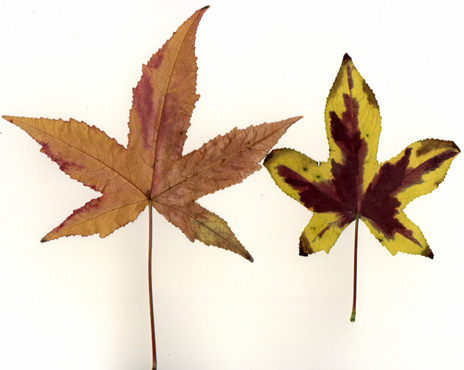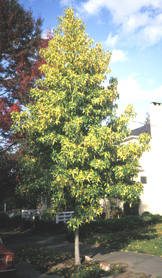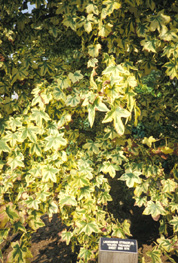Plant of the Month: November 2006
|
| 'Golden Treasure' Sweetgum |
Liquidambar Styraciflua 'Golden Treasure'
|
HAMAMELIDACEÆ; Witch Hazel Family
|
| This autumn I learned about two 'Golden Treasure' Sweetgum trees in the city of Seattle. I overlooked them earlier --thinking them merely stunted specimens of the common variegated Sweetgum clone-- and therefore left them out of my book Trees of Seattle. Now I must do them justice. Before dealing with the variegated cultivars, first some information about sweetgum trees in general. They are common large shade trees. |
| The scientific name Liquidambar is a mongrel name from Latin liquidus, fluid or liquid, and the Arabic anbar (amber); in allusion to the fragrant terebinthine juice or gum called liquid storax which exudes from the bark of Liquidambar orientalis. This storax has been burned as an incense; other products from the trees are used in perfumery. The leaves, shaped starfish- or maple-like, smell sweet when crushed, like the leaves of Chinese Pistachio (Pistacia chinensis) and Smoke Trees (Cotinus). Adding the leaves to a compost pile makes for strong fragrance when the pile is turned. The tree's flowers are inconspicuous, in late spring. The fruit is a dry spiky seedball on a long stalk. |
| Liquidambar Styraciflua is the American Sweetgum. It is also known as Red gum, Starleaf gum, Gum tree, Alligator tree, Opossum tree, and Bilsted. It grows from the southern and eastern U.S. to parts of central America (as far south as Nicaragua). In 1651 the Spaniard Dr. Francisco Hernández (1515-1587) published an account of this tree's liquid amber. The tree's gum has been used for wounds, in medicine, as incense, and for chewing. Styraciflua is capitalized because it is an old generic name (from Greek storax, a gum, and fluo, to flow --storax flowing). Storax is an exuded aromatic balsam, originally from Styrax officinalis, but now obtained from Liquidambar orientalis. The wood of sweetgum trees has been used for many things, from cigar boxes to sewing machine cabinets. |
Aside from the objectionable litter of spiky woody seedballs (one half to one and a half inches wide), and an ability to easily buckle concrete sidewalks, sweetgum is a superb urban shade tree, symmetric in youth, becoming tall and irregular. Leaf retention and fall color varies greatly from sub-evergreen to brilliant autumnal color. At least in Seattle, some specimens hold "fall color" well into February or even March. The leaves measure 4 to 8 inches wide. The twigs can be heavily corky-ridged, hence the name alligator tree, as Peter Henderson explained in 1881: "this is the tree whose rough, triangular branches, are sold in the streets of New York as the Alligator Plant. These pieces of stick are sold by the thousands every season, to unsophisticated city men, with about as much chance of growing as their fence pickets."
|
| It is a large tree. Some champion size records |
| (height x trunk circumference, in feet and inches): |
| 200' x 21'6" near Florence, SC (1944) |
| 164' x 17'0" Lower Wabash Valley, IN (<1875) |
| 136' x 23'2" Craven County, NC (1986) |
Trunks have been noted to 22'0" around in Mexico.
|
In Seattle, the tallest specimens are 100 feet, the stoutest trunks are more than 9 feet in circumference.
|
| Many sweetgum cultivars exist. An account of them appeared in the Journal of Arboriculture, November 1984; 10(11) pages 309-312. My 1996 book North American Landscape Trees described 17 cultivars. My book Trees of Seattle lists 7 locations where readers can view specimens of 'Variegata' --the Gold Dust® or Variegated Sweetgum. All Seattle specimens of this clone are less than about 40 years old; the tallest are at View Ridge School (50th Avenue NE & NE 73rd Street), where of three trees, the tallest was 72 feet in 2005. |
| 'Variegata' was first described in 1880 in Europe, and has been in North America since 1914 or before. Most specimens here date from 1940 and onward; it is common. Properly called 'Variegata', it has been sold as: 'Aureum' or 'Aurea', 'Golden', Gold Dust®, and 'Goduzam'. The famous Ohio nurseryman Ed Scanlon championed it as Golden Sweetgum. He wrote: "Some leaves one half to three quarters gold; some speckled with gold. In fall the gold turns pink and the green turns red." |
| In contrast to the preceding cultivar of utterly ordinary growth and size, the clone 'Golden Treasure' is both variegated and more or less dwarf. It was raised in Australia, and introduced in 1974 by Duncan & Davies nursery of New Plymouth, New Zealand. The leaves are edged with gold, and in autumn change to cream or pale yellow and then white. The dark green portion turns vivid burgundy, and the lighter green becomes orange and pink. Also the twigs have corky ridges. I first saw one of these 'Golden Treasure' trees in 1992 in Oregon. It was at the North Willamette Experiment Station, and had been planted in March 1976. Sixteen years later, in 1992 it was still a very small tree --see photo below. Of various sweetgum trees there, 'Golden Treasure' was notably slow. According to a study, most sweetgum cultivars there were, after 10 years, 18.5 to 27.5 feet tall, while 'Golden Treasure' was only 11 feet. Not until 1994 did 'Golden Treasure' start getting sold much in the United States. It is still for sale. Some mail-order nurseries list it; such as: |
| River Rock Nursery of Clackamas, Oregon; www.rdrop.com |
Twombly Nursery of Connecticut; www.twomblynursery.com
|
| The two 'Golden Treasure' trees I found in Seattle are well established little street trees on N 43rd Street, just east of Fremont Avenue N. The taller is 12 feet; the trunks are about 3 inches thick. They are under electrical power wires. I suggest that more people plant this clone, wherever a cheerfully bright, relatively dwarf and troublefree shade tree is sought. You just need patience, because the shade will be a long time coming. |
There are still other variegated sweetgum cultivars, but I do not know of any in Seattle, nor have I direct experience with them. These include: 'Frosty', 'Manon', 'Moonbeam', and 'Silver King'. The clone 'Aurora' has been described both as variegated, and not so. Certainly the clone of it in North American commerce is not --but possibly the original Dutch clone was.
Back |

'Variegata' and 'Golden Treasure' sweetgum leaf scan by ALJ
|

'Variegata' sweetgum leaf photo by ALJ
|

'Golden Treasure' sweetgum photo by ALJ
|
|
|

